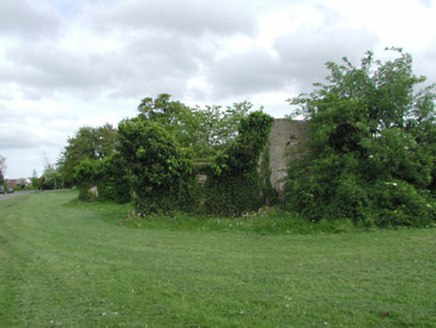Survey Data
Reg No
11216021
Rating
Regional
Categories of Special Interest
Social
Original Use
Country house
Date
1700 - 1760
Coordinates
314990, 227322
Date Recorded
15/05/2002
Date Updated
--/--/--
Description
Remains of detached five-bay two-storey split-level house, extant 1760, on a rectangular plan. Vacated, 1923. Now in ruins. Set in relandscaped grounds.
Appraisal
The fragmentary ruins of an early eighteenth-century house marked but not named on "AN ACTUAL SURVEY of the COUNTY of DUBLIN" (1760) by John Rocque (c.1704-62) and given the name The Priory when purchased (1790) by John Philpot Curran (1750-1817): Curran was the founder of a patriotic drinking club known as "The Order of Saint Patrick" whose members were styled "The Monks of the Screw" with Curran as their "Prior". Curran occupied The Priory for a quarter century and his time there was marked by episodes of personal tragedy: his twelve year old daughter, Gertrude (1780-92), died following a fall from a first floor window; his wife Sarah Creagh (1755-1844) eloped with Reverend Abraham Sandys (----); and his youngest daughter, Sarah (1782-1808), became romantically involved with Robert Emmet (1778-1803) leading to accusations that Curran was involved in the Irish Rebellion of 1803. The Priory was occupied by the Taylors at the turn of the twentieth century but thereafter fell into terminal decline. The Priory was described in "The Sunday Independent" as 'a long low building typical of the cottage type of country residence fashionable in the eighteenth century [so little changed] it does not require a very long stretch of the imagination to see Ireland's heroine, the gentle Sarah Curran, standing at the door impatiently waiting for some message from her sweetheart Robert Emmet' (The Sunday Independent 23rd November 1924) but an unnamed writer for "The Irish Times" later reported (12th September 1942) that 'even from a distance [it could be seen] that the house was a ruin. A two storey building of the early eighteenth century type, half of it without a roof, and a big enough hole in the other half to bare the rafters. Window frames are empty and partially rotted and the main entrance is without a door... Inside the house there were obvious signs of the cattle from the neighbouring fields having the right of way' (The Irish Times 12th September 1942). The ruins were soon described (1950) as 'beyond repair' and only fragments survived when the grounds were redeveloped as a suburban housing estate (1976) whose winding drives are named after the neighbouring Hermitage (see 11216043).

